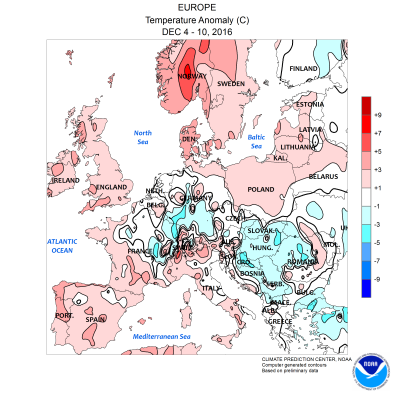Science Source
Summer heat waves over western Europe 1880- 2003, their change and relationship to large scale forcings
- Investigates the large-scale forcing and teleconnections between atmospheric circulation (sea level pressure, SLP), sea surface temperatures (SSTs), precipitation and heat wave events over western Europe using a new dataset of 54 daily maximum temperature time series
- States that 44 of these time series have been homogenized at the daily timescale to ensure that the presence of inhomogeneities has been minimized
- States the daily data have been used to create a seasonal index of the number of heat waves
- Uses canonical correlation analysis (CCA) and shows that heat waves over western Europe are related to anomalous high pressure over Scandinavia and central western Europe
- Finds that other forcing factors such as Atlantic SSTs and European precipitation, the later as a proxy for soil moisture, a known factor in strengthening land–atmosphere feedback processes, are also important
- States there is some useful predictive skill of summer heat waves using multiple lagged predictors
- Finds that a CCA using preceding winter North Atlantic SSTs and preceding January to May Mediterranean total precipitation results in significant hindcast (1972–2003) Spearman rank correlation skill scores up to 0.55 with an average skill score over the domain equal to 0.28 ± 0.28
- Finds—in agreement with previous studies focused on mean summer temperature—that there appears to be some predictability of heat wave events on the decadal scale from the Atlantic Multidecadal Oscillation (AMO), although the long-term global mean temperature is also well related to western European heat waves
- States that by combining these results with the observed positive trends in summer continental European SLP, North Atlantic SSTs and indications of a decline in European summer precipitation then possibly these long-term changes are also related to increased heat wave occurrence and it is important that the physical processes controlling these changes be more fully understood
Related Content
Real Time Data

Dec 16, 2016 | Climate Prediction Center | NOAA
Europe Weekly, Monthly, 3-Month Temperature Anomaly
Science Source
| World Meteorological Organization
Un/natural Disasters: Communicating Linkages Between Extreme Events and Climate Change
Susan Joy Hassol, Simon Torok, Sophie Lewis et al
Headline

Jul 11, 2016 | US News & World Report
Heat Waves Kill, Now We Know Why
Science Source
| Comptes Rendus Biologies / EU Community Action Programme for Public Health
Death toll exceeded 70,000 in Europe during the summer of 2003
JM Robine, SL Cheung, S Le Roy et al


